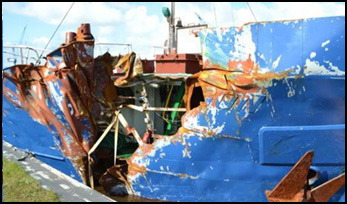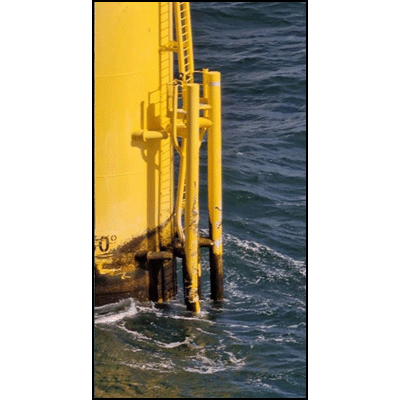-
What happened?
A cargo vessel collided with a wind turbine generator (WTG) foundation causing significant damage.
No technicians were present at the WTG as the impact occurred late in the evening.
The vessel did not raise the alarm or report the incident, and it was only observed by maritime authorities when the vessel arrived in port the next day.
Damage was also sustained by the WTG foundation. However, it continued producing throughout the event.
The wind farm operator remained unaware of the incident for 36 hours until contacted by the maritime authorities.

-
Why did it happen?
The vessel collision alarms in the wind farm operator offshore coordination control room did not raise attention to the situation as visual displays had recently been changed and the audio alarm system had been muted locally.
The audio system was muted due to the excessive number of alarms experienced in the control room and some were not relevant to the windfarms being monitored. Also, nearby fast maneuvering crew transfer vessels (CTVs) and fishing vessels were repeatedly triggering the same potential collision alarms.
Major changes to the functionality and displays of the vessel collision alarms in the site operation management system platform were changed without adequate communication and associated training.
The vessel collision alarm management system is essential for ensuring windfarms respond to potential collisions and take proactive measures. However, there was no requirement to periodically verify its functionality and effectiveness.
Additionally, there was a lack of clearly defined procedures for identifying and responding to alarms within the system.

-
What did they learn?
The offshore coordination centre plays a vital role in the effective monitoring and surveillance of wind farms, enabling proactive engagement with vessels on a collision course and ensuring thorough follow-up and review of any incidents where a potential collision has occurred.
It is essential that all systems and arrangements, including administrative controls, training, and resourcing, surrounding the offshore coordination centre are properly established and maintained to ensure coordinators can perform their duties effectively and efficiently.
Ensure that the systems in place fully support operators in performing their roles effectively. If any shortcomings are identified, seek consultation and feedback to determine necessary changes and improvements, thereby preventing potential mistakes.
Clearly define roles and responsibilities to facilitate effective change management and ensure that communication regarding critical systems used daily is clear and consistent.

-
Ask yourself or your crew
How can we ensure that our alarm systems are effectively prioritizing critical alerts?
What training programs can we implement to keep our team updated on system changes and emergency procedures?
How can we incorporate regular system checks into our maintenance schedule?
What specific procedures do we need to develop or improve to enhance our response to alarms?
How can we improve our incident reporting process to ensure timely communication and intervention?

Add to homescreen
Content name
Select existing category:
Content name
New collection
Edit collection
What happened?
A cargo vessel collided with a wind turbine generator (WTG) foundation causing significant damage.
No technicians were present at the WTG as the impact occurred late in the evening.
The vessel did not raise the alarm or report the incident, and it was only observed by maritime authorities when the vessel arrived in port the next day.
Damage was also sustained by the WTG foundation. However, it continued producing throughout the event.
The wind farm operator remained unaware of the incident for 36 hours until contacted by the maritime authorities.

Why did it happen?
The vessel collision alarms in the wind farm operator offshore coordination control room did not raise attention to the situation as visual displays had recently been changed and the audio alarm system had been muted locally.
The audio system was muted due to the excessive number of alarms experienced in the control room and some were not relevant to the windfarms being monitored. Also, nearby fast maneuvering crew transfer vessels (CTVs) and fishing vessels were repeatedly triggering the same potential collision alarms.
Major changes to the functionality and displays of the vessel collision alarms in the site operation management system platform were changed without adequate communication and associated training.
The vessel collision alarm management system is essential for ensuring windfarms respond to potential collisions and take proactive measures. However, there was no requirement to periodically verify its functionality and effectiveness.
Additionally, there was a lack of clearly defined procedures for identifying and responding to alarms within the system.

What did they learn?
The offshore coordination centre plays a vital role in the effective monitoring and surveillance of wind farms, enabling proactive engagement with vessels on a collision course and ensuring thorough follow-up and review of any incidents where a potential collision has occurred.
It is essential that all systems and arrangements, including administrative controls, training, and resourcing, surrounding the offshore coordination centre are properly established and maintained to ensure coordinators can perform their duties effectively and efficiently.
Ensure that the systems in place fully support operators in performing their roles effectively. If any shortcomings are identified, seek consultation and feedback to determine necessary changes and improvements, thereby preventing potential mistakes.
Clearly define roles and responsibilities to facilitate effective change management and ensure that communication regarding critical systems used daily is clear and consistent.
Ask yourself or your crew
How can we ensure that our alarm systems are effectively prioritizing critical alerts?
What training programs can we implement to keep our team updated on system changes and emergency procedures?
How can we incorporate regular system checks into our maintenance schedule?
What specific procedures do we need to develop or improve to enhance our response to alarms?
How can we improve our incident reporting process to ensure timely communication and intervention?
A cargo vessel collided with a wind turbine generator (WTG) foundation causing significant damage. No technicians were present at the WTG as the impact occurred late in the evening. The vessel did not raise the alarm or report the incident, and it was only observed by maritime authorities when the vessel arrived in port the next day.













